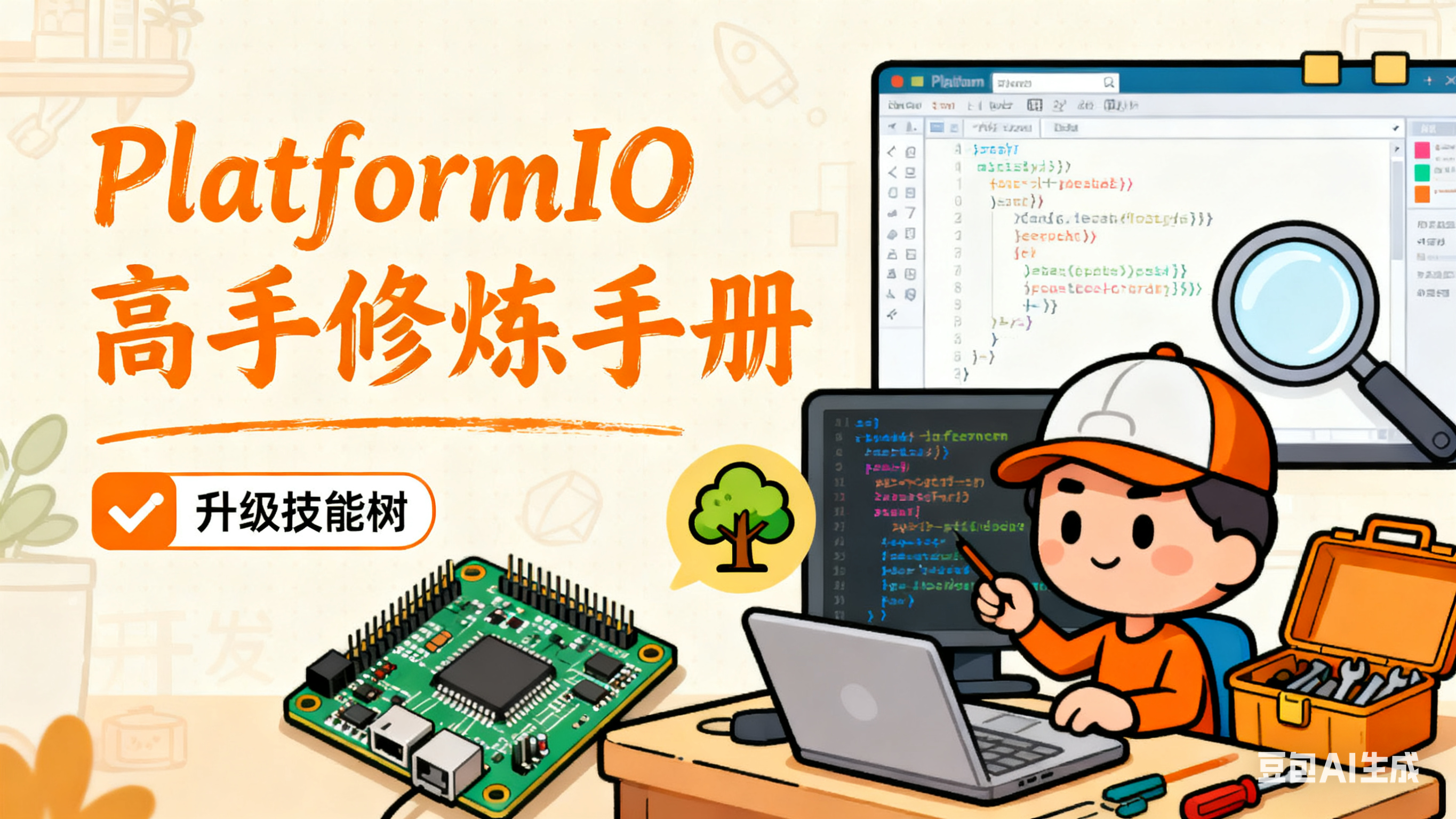
第一章:深入理解platformio.ini - 项目的控制中心
1.1 配置文件的结构解析
ini
; 这是一个完整的配置示例
[env:my_custom_setup] ; 环境名称,可自定义
platform = espressif32 ; 平台
board = featheresp32 ; 具体开发板
framework = arduino ; 开发框架
; 库依赖管理
lib_deps =
adafruit/Adafruit SSD1306@^2.5.7
bblanchon/ArduinoJson@^6.21.3
https://github.com/me/MyCustomLibrary.git
; 编译配置
build_flags =
-D MY_CONFIG_VALUE=42
-D SERIAL_BAUD=115200
-Wl,-Map=output.map
; 上传配置
upload_port = /dev/cu.usbserial-1410
upload_speed = 921600
; 监视器配置
monitor_speed = 115200
monitor_filters = colorize, log2file
; 调试配置
debug_tool = esp-prog
debug_init_break = tbreak setup1.2 多环境配置实战
为不同场景创建多个配置环境:
ini
; 开发环境 - 带调试信息
[env:esp32dev]
platform = espressif32
board = featheresp32
framework = arduino
build_flags = -D DEBUG_MODE=1 -g3
lib_deps =
adafruit/Adafruit SSD1306
; 生产环境 - 优化大小
[env:esp32prod]
platform = espressif32
board = featheresp32
framework = arduino
build_flags = -Os -D NDEBUG
lib_deps =
adafruit/Adafruit SSD1306
; 测试环境 - 单元测试
[env:esp32test]
platform = espressif32
board = featheresp32
framework = arduino
build_flags = -D UNIT_TESTS=1
lib_deps =
adafruit/Adafruit SSD1306
unity = https://github.com/throwtheswitch/unity.git第二章:高级调试技巧 - 告别Serial.print
2.1 硬件调试设置(以ESP32为例)
- 配置platformio.ini:
ini
[env:esp32-debug]
platform = espressif32
board = featheresp32
framework = arduino
monitor_speed = 115200
debug_tool = esp-prog
debug_init_break = tbreak setup
build_flags = -Og -g3- 设置断点和监视:
cpp
#include <Arduino.h>
volatile int counter = 0; // volatile告诉编译器不要优化这个变量
void setup() {
Serial.begin(115200);
pinMode(LED_BUILTIN, OUTPUT);
// 在这里设置断点 - 点击行号左侧
}
void loop() {
counter++;
digitalWrite(LED_BUILTIN, HIGH);
delay(100);
digitalWrite(LED_BUILTIN, LOW);
delay(100);
// 条件断点:当counter==50时停止
if (counter == 50) {
Serial.println("Counter reached 50!"); // 设置断点于此
}
}2.2 调试工作流:
-
点击底部状态栏的"Bug"图标开始调试
-
使用调试控制栏:
-
⏸️ 暂停/继续
-
🔴 停止
-
⏭️ 单步跳过
-
⬇️ 单步进入
-
⬆️ 单步跳出
-
-
在左侧"运行和调试"面板查看变量、调用堆栈
第三章:自定义库开发与管理
3.1 创建自己的库
项目结构:
text
MyProject/
├── lib/
│ └── MySensorLib/
│ ├── src/
│ │ ├── MySensorLib.h
│ │ └── MySensorLib.cpp
│ ├── examples/
│ │ └── BasicUsage/
│ │ └── BasicUsage.ino
│ └── library.json
├── src/
│ └── main.cpp
└── platformio.ini3.2 library.json配置:
json
{
"name": "MySensorLib",
"version": "1.0.0",
"description": "A custom sensor library for PlatformIO",
"keywords": "sensor, i2c, temperature",
"repository": {
"type": "git",
"url": "https://github.com/username/MySensorLib.git"
},
"authors": [
{
"name": "Your Name",
"email": "your.email@example.com"
}
],
"license": "MIT",
"dependencies": {
"adafruit/Adafruit BusIO": "^1.14.1"
},
"frameworks": "arduino",
"platforms": ["espressif32", "atmelavr"]
}第四章:单元测试与持续集成
4.1 创建单元测试
在项目根目录创建test文件夹:
text
test/
└── test_sensor/
├── test_main.cpp
└── platformio.initest_main.cpp:
cpp
#include <Arduino.h>
#include <unity.h>
#include "MySensorLib.h"
MySensorLib sensor;
void test_sensor_initialization(void) {
TEST_ASSERT_TRUE(sensor.begin());
}
void test_sensor_readings(void) {
float temp = sensor.readTemperature();
TEST_ASSERT_FLOAT_WITHIN(100.0, 25.0, temp); // 允许±100°C误差
}
void setup() {
delay(2000); // 给平台时间准备
UNITY_BEGIN();
RUN_TEST(test_sensor_initialization);
RUN_TEST(test_sensor_readings);
UNITY_END();
}
void loop() {
// 空
}4.2 运行测试
bash
# 运行所有测试
pio test
# 运行特定测试环境
pio test -e esp32test
# 详细输出
pio test -v第五章:高级构建技巧
5.1 自定义构建脚本
创建extra_script.py:
python
Import("env")
# 自定义构建后操作
def after_build(source, target, env):
print("执行自定义构建后操作...")
# 生成版本信息文件
import datetime
build_date = datetime.datetime.now().strftime("%Y-%m-%d %H:%M:%S")
with open("firmware_info.txt", "w") as f:
f.write(f"Build date: {build_date}\n")
f.write(f"Board: {env['BOARD']}\n")
f.write(f"Framework: {env['PIOFRAMEWORK'][0]}\n")
print("固件信息文件已生成!")
# 钩住构建过程
env.AddPostAction("buildprog", after_build)在platformio.ini中引用:
ini
extra_scripts = pre:extra_script.py5.2 条件编译
cpp
#include <Arduino.h>
// 根据环境选择不同的实现
#ifdef ESP32
#define LED_PIN 2
#define PLATFORM_NAME "ESP32"
#elif defined(ARDUINO_AVR_UNO)
#define LED_PIN 13
#define PLATFORM_NAME "Arduino Uno"
#else
#define LED_PIN LED_BUILTIN
#define PLATFORM_NAME "Unknown"
#endif
void setup() {
Serial.begin(115200);
pinMode(LED_PIN, OUTPUT);
Serial.print("运行在: ");
Serial.println(PLATFORM_NAME);
#ifdef DEBUG_MODE
Serial.println("调试模式已启用");
#endif
}第六章:专业工作流
6.1 版本控制集成
创建.gitignore文件:
text
.pio
.pioenvs
.piolibdeps
.piolibgen
.fv
.vscode/
*.elf
*.hex
*.bin6.2 自动化任务
在.vscode/tasks.json中:
json
{
"version": "2.0.0",
"tasks": [
{
"label": "Build and Upload",
"type": "shell",
"command": "pio",
"args": ["run", "--target", "upload"],
"group": "build",
"problemMatcher": ["$platformio"]
},
{
"label": "Clean Build",
"type": "shell",
"command": "pio",
"args": ["run", "--target", "clean"],
"group": "build"
},
{
"label": "Run Tests",
"type": "shell",
"command": "pio",
"args": ["test"],
"group": "test"
}
]
}第七章:实战项目 - 智能环境监测站
完整的platformio.ini:
ini
[env:smart_station]
platform = espressif32
board = featheresp32
framework = arduino
monitor_speed = 115200
; 库依赖
lib_deps =
adafruit/Adafruit BME280 @ ^2.2.2
adafruit/Adafruit SSD1306 @ ^2.5.7
bblanchon/ArduinoJson @ ^6.21.3
thingpulse/ESP8266 and ESP32 OLED driver for SSD1306 displays @ ^4.4.0
; 构建配置
build_flags =
-D SENSOR_READ_INTERVAL=5000
-D OLED_DISPLAY=true
-D WIFI_SSID=\"MyWiFi\"
-D WIFI_PASS=\"MyPassword\"
-Os
; 文件系统支持
board_build.filesystem = littlefs
; 上传配置
upload_speed = 921600项目结构:
text
SmartStation/
├── data/ # Web文件
│ ├── index.html
│ └── style.css
├── lib/
│ └── ConfigManager/ # 配置管理库
├── src/
│ ├── sensors/ # 传感器模块
│ ├── display/ # 显示模块
│ ├── network/ # 网络模块
│ └── main.cpp
├── test/ # 测试代码
└── platformio.ini第八章:性能优化与问题排查
8.1 内存优化技巧
cpp
// 使用PROGMEM存储常量数据
const char large_text[] PROGMEM = "这是一个很长的字符串...";
// 使用F()宏避免字符串复制
Serial.println(F("这个字符串不会占用RAM"));
// 优化数据结构
struct SensorData {
float temperature;
float humidity;
float pressure;
uint32_t timestamp;
} __attribute__((packed)); // 压缩结构体8.2 常见问题排查
bash
# 查看详细构建信息
pio run -v
# 清理并重新构建
pio run --target clean
pio run
# 查看库依赖树
pio lib list --global-storage
# 检查内存使用
pio run -t checkmem学习路径建议
-
第一周:掌握platformio.ini的多环境配置
-
第二周:练习硬件调试,学会设置断点和监视变量
-
第三周:创建自己的库并编写单元测试
-
第四周:完成实战项目,整合所有学到的技能
这份进阶教程将带你从PlatformIO使用者转变为真正的嵌入式开发专家。每个章节都配有实际可运行的代码示例,建议你跟着教程一步步实践,遇到问题时善用PlatformIO的文档和社区资源。
祝你早日成为PlatformIO高手!